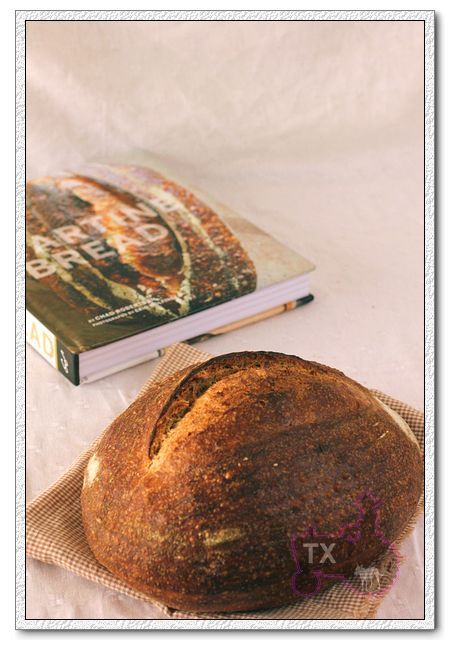
This is the WW loaf from the new "Tartine" Book, the procedure is very similar to the basic country loaf (which I posted about here), just with more WW flour(~70%) , even more water(80%+), and slightly lower mixing temperature since whole grain flour fermentate faster.
One thing that bothers me about the book is his math - when he calculate baker's percentage for ingredients, he doesn't count flour in the levain. He doesn't use a lot of levain, so in reality it probably doesn't matter, but it bothers my engineering brain. That's why I adjusted the formula, so the ww amount is really 70%, both in levain and final dough. Phew, feel a lot better after that.
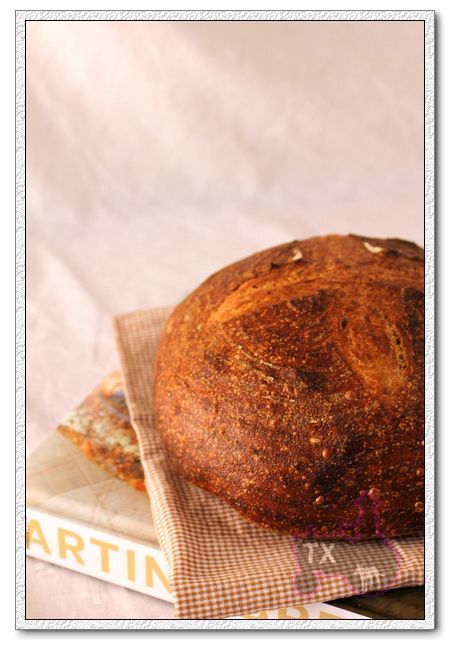
-Levain:
100% sourdough starter, 1/2 tbsp (I used 8g)
WW flour, 140g
white flour, 60g
water(78F), 200g
1. Mix and put in a cool place until it grows by 20%. If you pinch a bit of levain and put it in water, it should float. About overnight at 65F.
-Final dough
200g levain
700g ww flour
300g bread flour (book says AP flour but I used BF for the extra lift)
water(75F), 800g (I used a bit more, probably 20g)
salt, 20g
2. Mix levain, flour, 750g of water. Autolyse for 40 to 60min. Add the rest of water and salt, mix to combine.
3. Bulk rise around 80F for about 3 hours until it increase about 30% in volume. S&F every 30min in the first 2 hours, after that S&F according to what the dough needs. If mix with cooler water and let rise in cooler temp, the bulk rise time can be adjusted.
4. Divide and round, bench rest for 20min
5. Shape and proof upside down in floured brotform. I retarded my shaped dough in the fridge (40F) overnight, then warm up for another 30min before baking. The dough can also be proofed right after shaping for 3 to 4 hours at 75F to 80F.
6. Bake with steam for 45min at 450F.
Awesome oven spring, crackling thin crust that sang loudly. Since it's a very soft high hydration dough, at the begining of the bake, it tends to spread a bit, so I kept the oven temp at 500F for the first 5min, then dropped to 450F after that. The finished loaves are quite round and tall.
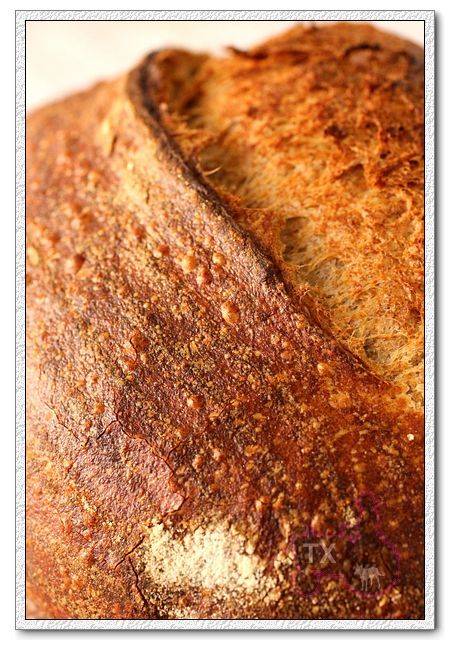
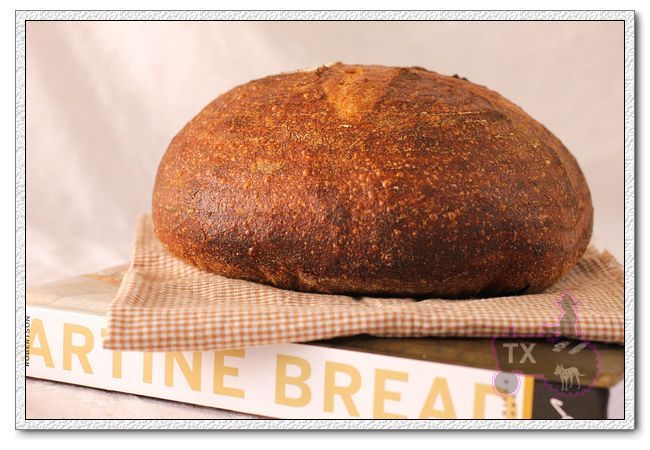
Quite an open crumb for so much ww
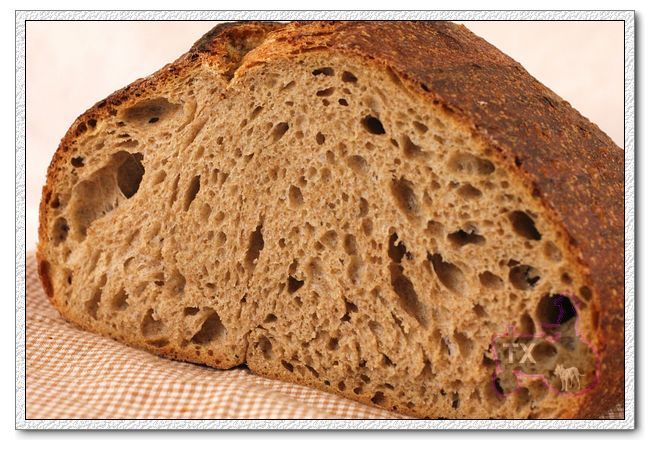
It's not quite as "hole-y" as the basic country loaf. Chad Robertson says whole grain hearth bread can indeed have open crumb, even though it might depend on many things including the type of the flour. I might increase the hydration even more to see how much I can push it.
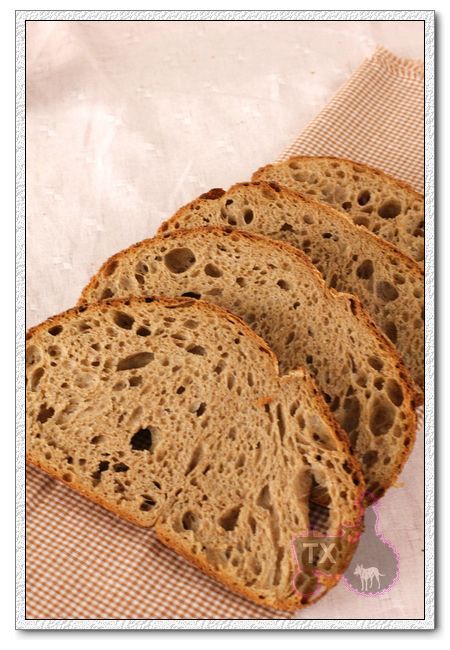
Just like the basic country loaf, this bread is not noticably sour, but very sweet, very fragrant with whole grain flavor. Next up, I want to try the semolina formula.

Sending this to Yeastspotting.
- txfarmer's Blog
- Log in or register to post comments
I have a bad case of crispy crust envy. And I'm facing 3 weeks until the next bake, most likely. <shudder>
David
That's a lifetime! :P
I really think you will get the crispy crust easily by just leaving it in the oven (uncovered) a little longer.
1/2 tablespoon of starter? That's it? And what an incredible crumb!
It does have a levain build, so that 1/2 tbsp of starter is just the seed.
Just delicious looking! A wonderful representation of the tartine whole wheat loaf.
It tastes great, so fragrant with that natural ww flavor.
You've been making such beautiful breads from Tartine. I bet a lot of TFLers will go out and buy the book. It may be nice to have a Baking from Tartine Challenge.
This book is not like BBA/"Bread", it's not a cover all bread making book, it's a typical "bakery book", which means it only has a couple of basic formulas, and some flavor variations. I am not sure it would make a good challenge book, not diverse enough IMO.
Hi txfarmer
I've been checking out your posts and gorgeous breads for some time, but have never actually commented until now. Always seem to be in a rush. I've been meaning to add my applause to the gathering crowds...it's well past time to take action! So, consider me another fan!
Like you, I love a thin crisp crust, and this one looks fabbo. And o how sweet, mysterious and gratifying a singing loaf!
Lovely crumb on this one, too - and as you say, especially considering the relatively high proportion of wholemeal flour in the dough. Your description of the flavour is too much for me...I have been working methodically and chronologically through my must-bake list, but this baby's jumped the queue and shot up to the top (right next to your sourdough baguettes)!
Cheers!
Ross
Your post brings a smile to my face, I am glad my baking experiments have been helpful!
Your baking is just Stunning and Gorgeous! I especially like the way you keep all the flour marks off your loaves after they have rested in the bannetons, if I use less flour I have a problem with loaves sticking. Would you mind sharing how you accomplish the loaves without sticking or flour rings? Maybe even a photo of your prepared bannetons : ) It makes for such a lovely crackly,birdseye crust, I so much admire in your bakes, getting rid of all that flour on the crust.
Sylvia
I dump part rice flour part AP flour into brotform, shake the flour around so it gets into the creases, then dump out excess flour. That's really all I do, 99% of the loaves come just fine. In fact the Tartine basic country loaf was the first one that got stuck a little, but with a little shaking, it came out without tearing the dough at all. Next time I will try to take a picture of the prepared brotform, I think rice flour is the key, and a taunt smooth surface of the shaped dough.
for your reply. I use rice and AP but still get flour lines :/ the rice flour is great for non sticking.
Sylvia
Umm.. you got it all, Txfarmer! you never miss out on any detail to push your breads into perfection!
Truely Lovely Lovely wholewheat bread, txfarmer.
khalid
Khalid, you have been turning out great looking ww loaves yourself, very inspiring.
Mine didn't look like yours - though pretty light for my ww breads - but the taste was out of this world!
Can see myself working on this one for the next few months... Thanks!
The first time I made it using bread flour for the white flour and it worked just great. Good oven spring and the taste was fantastic. The dough was a little wetter than I am used to but not that difficult to handle.
The second time I used all purpose flour for the white flour and while the taste is good the dough was far wetter and spread too much. I think I will have try varying the water until I get it to work right with the flours I am using.
What I do like about this bread is that it has the benefits of sourdough without being too sour. I am not a huge fan of the real sour sourdough loaves. I like a little tang and that is all. This bread gives me that.
The other variable I want to mess with is trying to mix various flours in different proportions to see what that does. What I hope to end up with is a good 30-40% mix of whole wheat and rye flour combined with the balance being white flour, probably bread flour. That would give me the kind of taste I want for the kind of uses I will have for this bread.
Another thing about this bread is that it is very easy to make. You build the starter and leave it for a while, then mix everything but the salt and a little water and leave it for a while and finally add the salt and last bit of water, mix and then do stretch and folds every half hour until the dough feels right. Then you do a shape and rest followed by the final shaping and bake. I am trying to talk a friend who is breaking away from a bread machine to doing his own mix, knead and shape to try this out. It will be interesting to see how he does with it.
Thank you for posting this. Your bread looks delicious. I was almost out of whole wheat flour so instead of whole wheat and bread flour I used just extraction flour and about 200 g of whole wheat. I'm happy with the results but I'll do it again with whole wheat and white flours when I get some more. Here's what it looked like:
-greg
Wonderful bread txfarmer. An inspiration...but alas I am traveling tomorrow and the weekend so inspiration must wait!
Thanks!
Jay
That's amazing crumb for 70% whole wheat.
I'm giving that a try and have a quesiton about retarding the shaped loaves. It sounds like you shape the loaves and put them in the fridge immediately for an overnight retardation. when removing from the fridge, do you warm the loaves and then let them proof to double in volume or warm them for an hour or so and bake? With what little retarding of sourdough shaped loaves I've done, the loaves haven't risen much.
FF
Your probably have missed the following in the post:
" I retarded my shaped dough in the fridge (40F) overnight, then warm up for another 30min before baking."
However it's always a bad idea to just following the time. YOu need to follow how the dough feels. When pressed, it needs to feel like there's still some bounce left in the dough (so you can get ovenspring). If it feels too bouncy, give it more time in the room temp to proof further; otherwise just bake. I retard shaped dough all the time, if I make sure the dough feels right after the bulk rise, as well as the proof, I always get great volume.
Good advice.
You give great tips in a way that I can understand exactly what you mean. I will be trying this bread soon I think. It's been years since I tried a bread started with levain that has so much whole wheat in it, but yours has made me want to again. I love whole wheat, but I had a real bad reaction to it years ago and I am only just starting to eat it again. That bread just looks so awesome, I must try it!
Joanne
I am so happy you wrote out how you have baked this loaf and have included pictures as well!!! I love how you are so thorough with your process.
I was feeling a bit overwhelmed by simply reading about his process in the book and now that I have your step-by-step method to follow I feel much better about jumping in and giving this loaf a try. (I have thoroughly enjoyed all the loaves of yours that I have baked - in fact today I am working on the bulgar loaf :-) )
Now I can ask you a couple of things that weren't quite clear to me in the book.
He states to use the starter when it has risen only 20% which you mentioned above too. I am use to using my starter once it has just peaked (matured) which is usually when it has doubled or tripled. Does this mean that he uses the starter BEFORE it has fully matured?
If so then this is a new concept to me because I thought I am supposed to wait for my starters to fully rise before using or else they don't raise the doughs since all the yeast hasn't developed yet...
Can you please explain it a bit to me?
ALso, I see by your numbers that you build 400g of leaven but only use 200g when mixing with final dough ingredients. Is there a reason why you make the 200g extra?
As always - thanks for your help!
Janet
1. Yes, you use the starter before it's matured/peaked. It will still raise the dough, just takes a bit longer. The point here is to control sourness.
2. I made the extra as the book instructed, used the extra as starter for next time. Feel free to make only 200g if you wish.
Thank you for clearing this mystery up for me! Now I know another way to use my sourdough as well as a new way to create different flavors. I have learned much from all you have contributed here. I feel much more confident about trying his loaf now.
Best Wishes,
Janet
So how long will this extra levain be good for? Can it be kept in the fridge only or in the freezer as well?
Hi,
If not retarded, do you think this bread needs to be baked in a container to prevent too much spread?
Have you baked it on your stone? If so, how did you steam?
Thanks, it's hard to find good WW formulas.
I have not posted in a couple of years; just too busy with my home baking business and grandchildren. However, this posting is amazing--txfarmer, what a wonderful bread and posting here. As for "it's hard to find good ww formulas," I totally agree. Aside from WW sandwich breads with plenty of yeast (and usually a percentage of white flour), the best place I've found is the Community Grains website. It's a new company started by Bob Klein of Oliveto Restaurant in Oakland and a hot topic here in No. Calif. They have just had a conference focusing on the health benefits and method of milling stoneground whole wheat with the whole grain-no splitting into parts, no tempering the grain with water. Check out www.communitygrains.com for details. I have just "put to bed" (retarding in fridge for 15 hours) a 100% whole-grain WW sourdough boule. Here's the link: http://communitygrains.com/frankie-olives-hard-red-winter-wheat-boule. First time I've tried it, and it takes over 24 hours in all (maybe 2 hours of active work). Craig Ponsford shows how he makes his pizza/ciabatta dough on a video on the website. There are recipes for several 100% WW breads on the website. The trick is getting the Community Grains hard red winter wheat flour. It's like none other. (I've used Bob's Red Mill stoneground WW, which is a good substitute but not the same.) I finally had success getting our local Whole Foods (Santa Rosa Coddingtown store) to carry it in bulk. It's also in bulk bins at Rainbow Market in S.F. and (I think) Bi-Rite and Good Eggs in S.F. and Berkeley Bowl, northside store. The flour comes from Woodland, CA, milled at Certified Foods, Joe Vanderliet, miller. He's quoted in Michael Pollan's latest book, Cooked, in the chapter on "Air." It's a great read.
Joy
Well, here goes my attempt to load a picture of that whole wheat sourdough using Community Grains hard red winter whole wheat. I baked it in my round cloche (preheated the top and proofed it in a basket lined w/ parchment, which made a transfer to the cloche bottom easy). Hubby couldn't wait the 2 hours before slicing off a piece, so it was a little bit "moist." But not too bad. But there was that open cavity right near the crust where it was the darkest. Oh well, it didn't go in too far, and the crumb was relatively open, at least for 100% w/w. It was a little early for tasting (Francis-Olive said to wait 2 hours before slicing), so I guess it would flavor up in another hour or so. But it was a good loaf, that whole wheat flavor, not that "sweet wheat" flavor--or divine aroma--I get with sourdoughs with multigrains (I usually bake Hamelman's sourdough with mixed starters--one rye and one w/ predominantly bread flour). I coated it with wheat bran (sieved from a coarse grind of w/w flour), which suited it very well. So, would I make it again? I don't think so (I have one customer who's wanting 100% w/w, which is my main motivation). My next attempt will be Emmanuel Hadjiandreou's w/w sourdough, which looks much simpler (much, much less time and less refrigeration than this one). Apparently the acid created by the sourdough aids in gluten development, critical for 100% w/w. And then there's the "Ligurian-Style Whole-Grain Focaccia" and the w/w sandwich bread by Sarah Bruhns (both from the Community Grains website). Better check in with my customer to see what she is after, hadn't I?
Joy